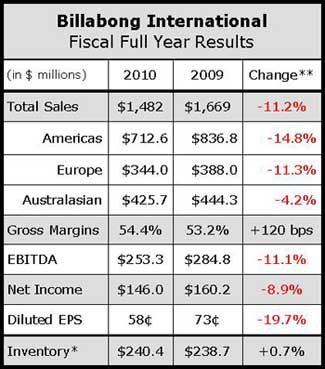Australian surfwear manufacturer Billabong International, Ltd. said it had a “solid second half performance” for the fiscal second half ended June 30, although a weak first half was too much for the company’s full year to overcome.
Despite a modest recovery from retail within the U.S. and Europe, Billabong management said adverse currency fluctuations and weakness from Australia hindered results for the year. Furthermore, management also said EBITDA margins were “affected by the allocation of global overhead costs to each segment.”

For the year, consolidated sales for Billabong were A$1.48 billion ($1.3 bn), which is flat compared with last year in constant-currency terms. Net profit for the year was A$146.0 million ($129.0 mm), up 8.1% in constant currency terms from last year.
Weak trading results in Japan, New Zealand and South Africa along with “continued change in regional mix” were cited by the company as reasons for softness in the Australasia region, where sales dipped 1.9% in constant-currency terms. EBITDA for the region fell 10.3% for the full year after falling 14.0% on the first fiscal half. In Australia, management said a “sharp consumer slowdown” during the trailing three months resulted from a decline in tourists in key locations.
For the Americas, revenues improved 3.2% in constant-currency terms during the second half but were down 1.2% for the full year. EBITDA margins improved to 13.0% on strength during the second half while EBITDA for the full year was up 5.4%. Management said the all-important U.S. market showed “steady improvement” through the year although tight credit conditions hampered the operations of the small specialty retail account base. Overall, the company reported there was “a shift towards more normalized ordering patterns” as its wholesale account base reduced its reliance on price and value-based products in favor of more proven product.
By brand, management said Nixon improved double-digits in the U.S. while DaKine, Tigerlily, Xcel, Honolua and Kustom all recorded “favorable” results. The Billabong and Element brands suffered from the continued deterioration in sales to Pacific Sunwear, where revenues plummeted 40% for the year. PacSun now only accounts for about 6% of Billabong’s North American sales.
Billabong said the East Coast outperformed the West Coast during the year, as stores on the Pacific seaboard saw a slow start to summer due to unseasonably cold weather. Retailers around the Gulf states were adversely impacted by the oil spill. South America improved 10.6% on strength from Brazil and Peru.
In Europe, sales improved 7.6% in constant-currency terms during the second half, boosting full year sales 5.2% over the prior year. EBITDA was up 13.9% in the second half in constant currency terms, lifting full year EBITDA to A$69.8 million (US $61.6 mm), up 5.1% from A$66.4 million (US $49.7 mm) in the prior year.
Regarding outlook, management said it views 2010-2011 as a “transition year” as it implements several initiatives and “strategic moves.” Management expects net profit to improve 2% to 8% in constant currency terms as an improving outlook in the Americas and continued strength in Europe is offset by a “challenging market” in Australia.













